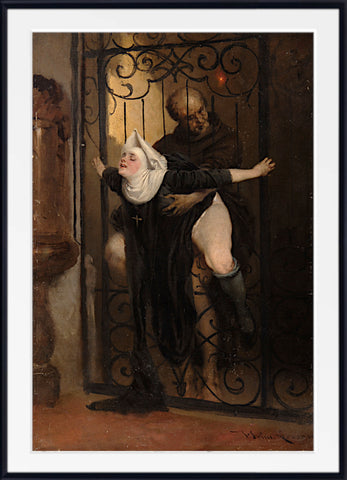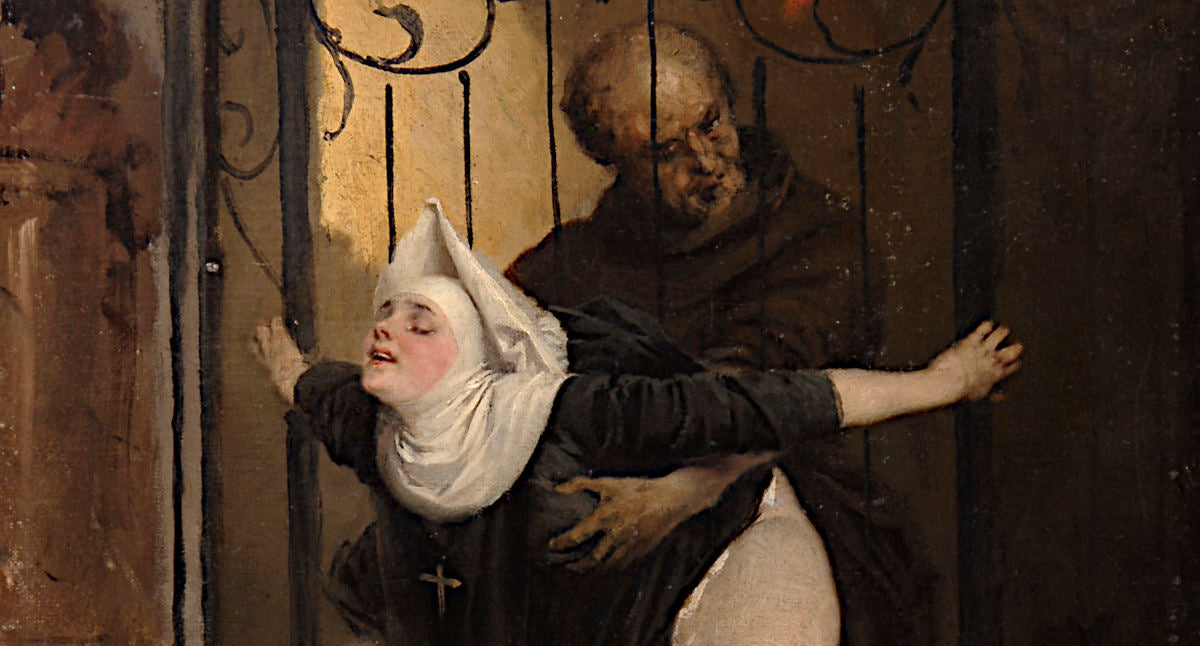Table of Contents:[hide]

image : The Sin by Heinrich Lossow
The plot of the picture The Sin is thematically related to the “Banquet of Chestnuts”. This name was given to a scandalous dinner, allegedly held in the Papal Palace by the former Cardinal Cesare Borgia, the son of Pope Alexander VI on October 30, 1501. The banquet report was preserved in the Latin diary of the Protonotarius the Apostle and the ceremonies of Master Johann Burchard (it is called Liber Notarum), but its accuracy is disputed.
The scene of the Sin : "Banquet of Chestnuts”
On October 30th, 1501, Cesare Borgia, son of Pope Alexander VI, allegedly hosted an extravagant dinner party. According to Johann Burchard's account, the event featured nude courtesans crawling among candelabras, using their mouths to collect chestnuts. To add to the scandal, prizes were awarded to guests who engaged most frequently in intimate acts with the courtesans. This shocking incident pushed the boundaries of decency.
Interestingly, Lossow's painting focuses on the sexual aspects of the banquet rather than the chestnut-gathering courtesans, though the reason for this artistic choice remains a mystery. It's crucial to note that the authenticity of the Banquet of Chestnuts is primarily based on Burchard's Latin diary, Liber Notarum, which has been a topic of much debate.
According to Burchard, the banquet took place in Cesare's chambers in the Palazzo Apostolico, with fifty courtesans entertaining the guests. He vividly described the scene in his diary, providing the only known written account of this notorious event:
"On the evening of October 31st, 1501, Cesare Borgia organized a feast in his Vatican chambers with 'fifty honest prostitutes,' or courtesans, who first danced in their clothes and then naked with servants and other attendees. After dinner, candelabras with burning candles were placed on the floor, surrounded by scattered chestnuts. The courtesans picked up the chestnuts while Pope Alexander VI, Cesare, and his sister Lucretia watched. Prizes were given to those who engaged frequently in intimate acts with the courtesans. The winners received silk tunics, shoes, and other items."
Despite Burchard's detailed account, contemporary scholars have questioned the credibility of the Chestnut Banquet, citing its appearance only in his memoirs.
Lossow's painting, depicting this scandalous tale, caused a significant uproar upon its unveiling. The artist faced harsh criticism from art critics and the public alike, and even the Church condemned him for his bold portrayal of such sinful activities.
In the end, the truth about the Banquet of Chestnuts may remain elusive. However, one thing is certain: Lossow's painting, "The Sin," continues to captivate and intrigue viewers, inviting contemplation of the scandalous events it vividly depicts.
The Sin - A Controversial Painting
Despite the intense controversy surrounding "The Sin," Lossow's painting has made an enduring impact on the art world and popular culture. Its bold portrayal of the alleged Banquet of Chestnuts has sparked numerous discussions and analyses, captivating art enthusiasts, historians, and curious minds alike. The artwork serves as a reminder of the intricate and contradictory nature of the Borgia family, whose influence and power during the Italian Renaissance are well-documented. Despite their position in the clergy, the Borgias were expected to maintain high moral standards, yet stories of their excesses and debauchery have continued to pique interest and speculation about their lives.
While "The Sin" faced criticism for its audacious depiction of the Chestnut Banquet, it is crucial to recognize that art has the ability to initiate conversations and challenge prevailing beliefs. In this context, Lossow's work can be viewed as a bold exploration of human nature, desire, and the blurred line between reality and fiction. With time, the painting has gained a certain mystique, drawing attention not only for its subject matter but also for Heinrich Lossow's artistic skill and talent. The meticulous brushwork, the captivating play of color and light, and the intricate composition of the scene all contribute to the enduring allure of the painting.
As we continue to marvel at "The Sin," we are reminded of art's power to transport us to different eras and locations, to illuminate the intricacies of human behavior, and to spark our imaginations. Regardless of whether the Banquet of Chestnuts is a historical truth or an embellished tale, Lossow's painting has undeniably earned its place in the annals of art history.
Prints and Canvas Panels of the Sin are available in a range of sizes with fast worldwide delivery
FAQ's - The Sin Painting by Heinrich Lassow
Q1: What is the story behind "The Sin" painting by Heinrich Lossow? Answer: "The Sin" depicts the alleged Banquet of Chestnuts, a scandalous event hosted by Cesare Borgia, son of Pope Alexander VI, in 1501. The painting shows naked courtesans gathering chestnuts amidst candelabras while guests engage in intimate acts with them.
Q2: Is the Banquet of Chestnuts a historical event or a myth? Answer: The Banquet of Chestnuts is based on historical accounts, particularly Johann Burchard's diary. However, its authenticity has been debated, leading some scholars to question its factual accuracy.
Q3: Why did Lossow choose to paint this controversial event? Answer: The exact reason for Lossow's choice remains unclear. However, artists often explore provocative themes to challenge societal norms, and "The Sin" can be seen as a daring exploration of human nature and desire.
Q4: What artistic techniques did Lossow use in "The Sin" painting? Answer: Lossow employed meticulous brushwork, captivating use of color and light, and an intricate composition to bring the scene to life. His attention to detail enhances the painting's enduring appeal.
Q5: How did the public and art critics react to "The Sin" painting when it was first unveiled? Answer: The painting caused a significant uproar, facing criticism from both art critics and the general public. Even the Church condemned Lossow for his bold portrayal of sinful activities.
Q6: Is there any symbolic meaning behind the painting? Answer: While specific symbolism may vary, the painting is generally interpreted as an exploration of human indulgence, moral ambiguity, and the contrast between public facade and private behavior.
Q7: Where is "The Sin" painting currently located? Answer: The current location of the painting is unknown.
Q8: What is the legacy of "The Sin" painting in art history? Answer: "The Sin" has left an indelible mark on the art world, sparking discussions about historical accuracy, artistic freedom, and the boundary between reality and imagination. It continues to be a subject of fascination and scholarly inquiry.
Q9: Are there any other notable works by Heinrich Lossow? Answer: Heinrich Lossow created various other artworks during his career, although "The Sin" remains one of his most renowned pieces. His portfolio includes paintings, drawings, and illustrations, showcasing his diverse talent.
Q10: How can I learn more about Heinrich Lossow and his body of work? Answer: To delve deeper into Heinrich Lossow's artistry and explore his other creations, you can visit the collection page

